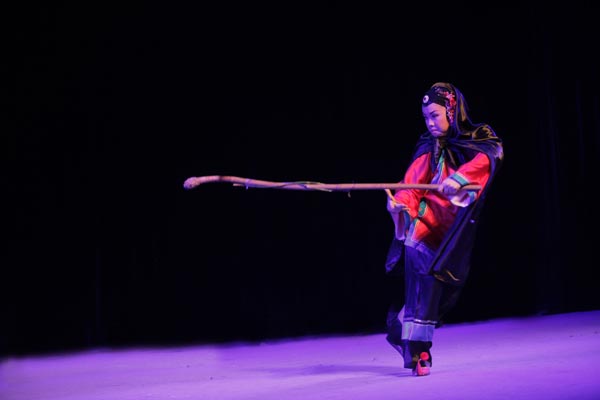 |
|
A "witch" waves her magic cane in the reproduction of Beauty and the Beast in Gaojia opera, a Chinese opera in Fujian. The opera will tour China and Europe next year. [Photo/China Daily] |
Belle is singing of her mixed feelings for the Beast - in Fujian dialect for the first time.
A new production of Beauty and the Beast, combining Gaojia opera with puppetry, had a preview showing at the ongoing China Shanghai International Arts Festival, winning praise from international theater artists, festival organizers and critics.
The formal production will tour China and Europe next year.
The playwright, Wang Xiaoxin, is from the Shanghai Theater Academy. "We choose to tell the story in Gaojia opera because it is a humorous and adaptable folk art," she says. "The story is familiar to young audiences all over the world, helping to attract them to the colorful theater presentation."
Gaojia opera has been active in Fujian for almost 300 years. "It's the most popular folk theater in the region. You still see many Gaojia opera performances at weddings, funerals and other ceremonial occasions in Fujian, especially in Quanzhou and nearby areas," Wang says.
Gaojia opera has borrowed freely from local ballads and folk art to develop a colorful and light-hearted style.
From traditional puppetry theater, Gaojia opera has adapted a way of walking and the performing style of circus clowns. That inspired Guo Yu, director of the play, to integrate puppetry into the production of Beauty and the Beast.
"We have strong resources at our academy about the traditional Chinese puppet theater, but the traditional art has been forgotten in the commercial theatrical scene," says Guo, who is also vice-director of the Shanghai Theater Academy.
In the show, the Beast is protrayed by Huang Zhihe, a Gaojia opera singer, while his original image, the handsome prince, mounts the stage as a life-size puppet.
The household items, which were transformed from domestic helpers by the witch, are also presented as puppets operated by the opera singers.
"We are still working on a second, third and even fourth draft," Guo says. As an academic institution creating a theater production, "we take it as a research project, and we can afford to try again and again before we arrive at a final edition."
For Gaojia Opera Troupe of Quanzhou, the largest of its kind in the city, the collaboration with Shanghai Theater Academy is a rare opportunity to innovate and access the international market.
"These artists are veterans with decades of experience of training and performing Gaojia opera. They have a great repertoire of traditional programs, and now they are hungry for new plays and innovation," says Wang.
The preview of 35 minutes has gained the attention of international institutions.
Peter Manscher, international coordinator for Teatercentrum (Theater Center), host of the annual Children's Theater Festival in Denmark, says he "would like it to be performed at our festival".
Fu Jin, professor at Nanjing University and chief editor of the academic journal Folk Opera Art, was particularly impressed with the performance of the witch in the play by Ke Shuping, for presenting "the brightest highlight of Gaojia opera".
Fu has witnessed growing interest in the adaptation of classical and popular Western stories to Chinese folk opera.
"There have been a growing number of successful projects like this in the past few years. The best thing about them is that it shortens the distance between Western audiences and traditional Chinese culture."
With the familiar storyline, non-Chinese audiences are likely to give their attention to the unique presentation of traditional Chinese theater, Fu says.
Ancient Greek classics, Ibsen's plays and many Shakespearian works have all had Chinese opera productions, some with stories and settings moved to China, some keeping the original period and location.
"You don't have to incorporate all the good stuff of China's culture in one project," Fu says. "Just let audiences have a taste of the sweetest essence, and they will come back for more."
|
|
|
|
|
|
|
|
